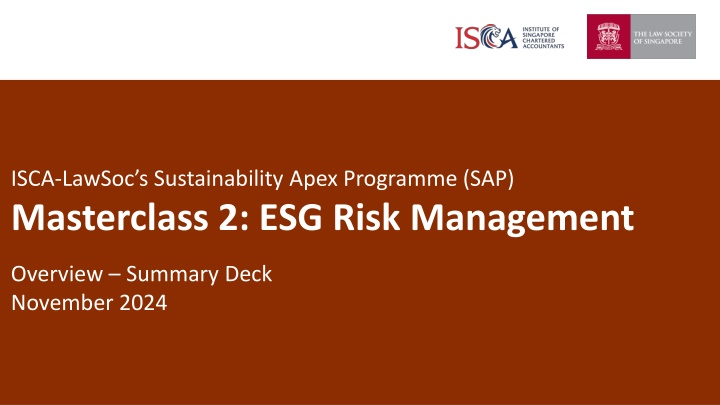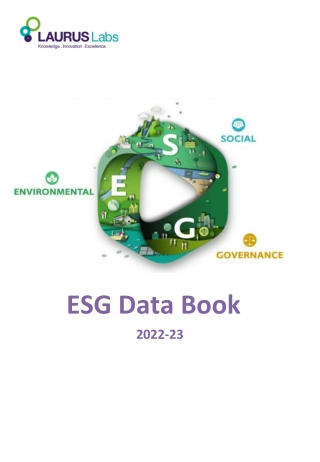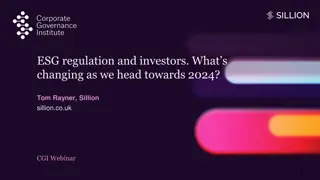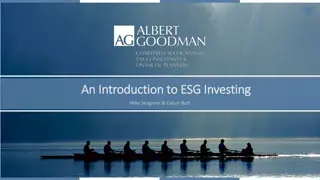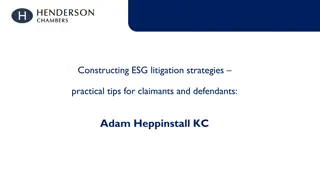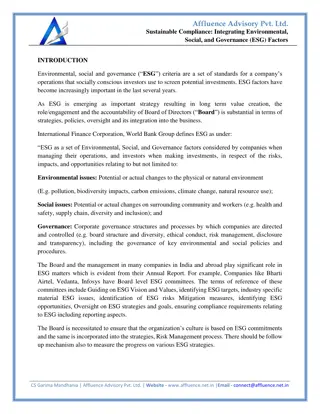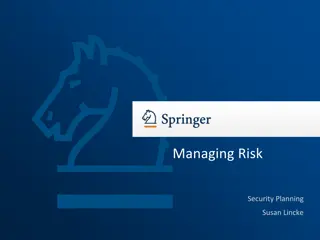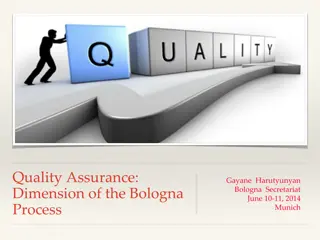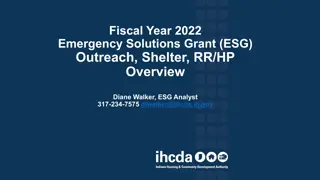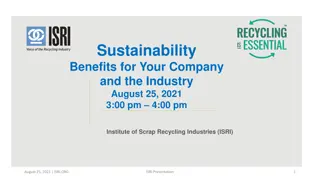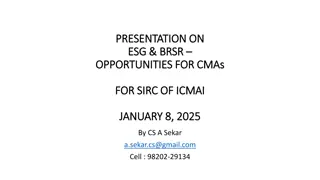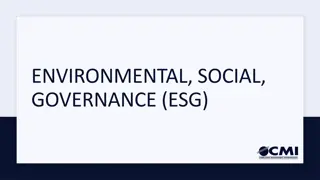ESG Risk Management Overview Summary - Nov 2024
Agenda for a masterclass on ESG risk management, covering types of ESG risks, current trends, importance of addressing ESG for organizational continuity and resilience, essential management steps, assessing material risks, mitigation strategies, and monitoring/reporting mechanisms. Detailed explanation of ESG-related risks, factors impacting financial performance, solvency, and potential impacts on institutions via environmental, social, and governance matters. Includes a holistic approach to assessing financial impacts and integrating ESG risks into a firm's risk landscape.
Download Presentation

Please find below an Image/Link to download the presentation.
The content on the website is provided AS IS for your information and personal use only. It may not be sold, licensed, or shared on other websites without obtaining consent from the author.If you encounter any issues during the download, it is possible that the publisher has removed the file from their server.
You are allowed to download the files provided on this website for personal or commercial use, subject to the condition that they are used lawfully. All files are the property of their respective owners.
The content on the website is provided AS IS for your information and personal use only. It may not be sold, licensed, or shared on other websites without obtaining consent from the author.
E N D
Presentation Transcript
ISCA-LawSocs Sustainability Apex Programme (SAP) Masterclass 2: ESG Risk Management Overview Summary Deck November 2024 1 1
Agenda for todays masterclass 01 02 Introduction to ESG Risk Understanding ESG Risk Management Highlighting the different types of ESG risks, current trends, and the importance addressing ESG organisation continuity resilience. Understand management essential assessing, mitigating, and monitoring ESG risks. Explore determine ESG risks that are material to your business, approaches to assess these risks and its impact, adopt mitigation strategies, as well as establish monitoring and reporting mechanism. the process, steps ESG risk 01 02 of for and covering identifying, risk of ways to 2
Definition of ESG-related risks ESG factors that may impact the financial performance and solvency of institutions via their counterparties ESG factors are Environmental, Social or Governance matters that may have a positive or negative impact on the financial performance or solvency of an entity, sovereign or individual. Environmental factors Social factors Rights, well-being and interests of people and communities, which may have an impact on the activities of the institutions counterparties Environmental and social risks are closely interrelated Also related to the social transformation towards a more inclusive, equitable society. Natural environment and processes Affect the entire value chain of companies as well as any other counterparties to which institutions are exposed ESG factors can have negative or positive impacts. From this perspective the ESG factors can be used also when evaluating opportunities for financial or non-financial entities related to the transition to a more sustainable economy. Governance factors Cover governance practices of the institutions counterparties, including the inclusion of ESG factors in policies and procedures under the governance of the counterparties Governance plays also a fundamental role in ensuring the inclusion of environmental and social considerations by a given counterparty. The relevance of ESG factors for institutions depends on their business activities, the type of assets (e.g. sectors and geographic location of counterparties, issuers of invested financial instrument) and liabilities (e.g. issuance of financial instruments, funding profile) that institutions hold. 3 Source: KPMG Global
ESG-related risks and its impact to organisations Non-Exhaustive Risk Types Relevant ESG risk drivers Transmission channels Businesses Households Environmental Climate Property damage Loss of income Business & Strategic Risk Market preferences Policy & Regulation Business disruption Property damage Technology Microeconomic Stranded assets / low asset performance High health risks Acute Chronic Increased maintenance costs Legal disputes / high legal liability Nature Pollution & Resources Operational Risk Land Water Pollution and Contamination Changing demand & costs Ocean Atmosphere Resource Efficiency Low profitability Financial Risk Social Risks Macroeconomy Consumers & Products Production & Supply Employee relations Macroeconomic Shift in prices Changes in labor market Long-term decay of some industrial sectors Governance Risks Socioeconomic changes (migration, conflicts) Compliance Risk Management & Values Transparency & Public relations Compliance violations Shift in demand & customer preferences A holistic approach is required for assessing the potential financial impact of ESG risks on firms and integrating ESG risks into firm s risk landscape. Source: TCFD, TNFD, COSO, KPMG Global 4
Long-term strategy of ESG risk management ESG risks affect organisations strategy in all fronts a holistic approach is needed. Once organisations have defined their ambition, built the structures and design their framework. Define direction 1 Good ESG risk management should be based on a resilient strategy. An organisation needs to be clear about its future positioning and identify the client segments and industries in which it wants to operate. The policy direction should be written down and implemented in appropriate governance frameworks for ESG risks. Build structures Governance 2 Good risk management requires the right processes, methods, tools and other aids. Organisations therefore need to address the design of the process and method package for managing ESG risks at an early stage and act according to the need. Design framework Design framework 3 It must be ensured that ESG risk factors are fully understood and integrated into all decision-making processes. Building up and obtaining the necessary data is not an insignificant challenge, but it is indispensable in order to adequately manage ESG risk factors. Enable new long-term growth 5 Source: KPMG Global
Summary of ESG Risk Management Cycle ESG risks affect organisations strategy in all fronts a holistic approach is needed. Once organisations have defined their ambition, built the structures and design their framework, it is important to implement the ESG Risks framework. Risk Identification Assessment & Prioritisation Understanding of organisation exposure towards ESG risk drivers Consider the impact of ESG risks on organisation operations, and prioritize material risks Identification Assessment Integration of ESG risks into the existing risk landscape Perform ESG-risk assessments, such as climate risk scenario analysis Assessment of ESG risks materiality within the risk inventory process Monitoring & Reporting Monitoring and Reporting Mitigation & Management Development of risk mitigation and preventive measures Identification of indicators related to ESG risks Mitigation Reporting on ESG risks (disclosure of risks, regulatory requirements etc.) Development of risk strategy and management of ESG risks Source: KPMGGlobal 6
